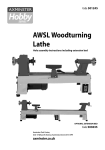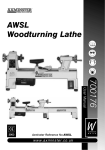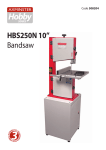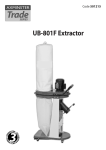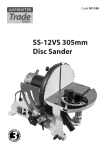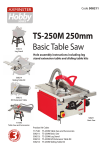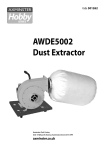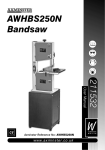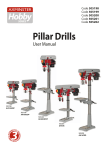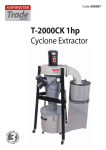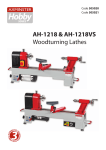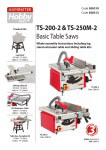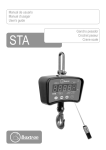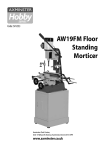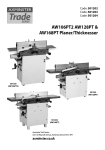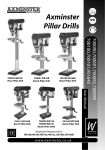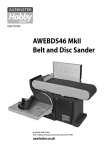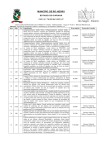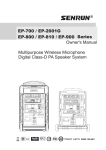Download Axminster AWDS12H Specifications
Transcript
AXMINSTER Code 501260 Hobby SERIES AWDS12H 300mm Disc Sander Index of Contents Page No Index of Contents 02 Declaration of Conformity 02 What’s in the Box 03 General Instructions for 230V Machines 04 Specific to Sanding Machines 05-06 Assembly07-08-09 Specifications10 Parts Illustraction and Description 11 Changing the Sanding Disc 12 Maintenance12 Illustrated Parts Breakdown 13 Illustrated Parts List 14 Notes15 Declaration of Conformity Copied from CE Certificate The undersigned, F. Nispel authorised by Laizhou Chunlin Machinery Co., Ltd. No.1 Fuquin East Road Laizhou, Shandong 261400 P.R.China declares that this product manufactured by Laizhou Chunlin Machinery Co. is in compliance with the following standards or standardisation documents in accordance with Council Directives Low Voltage Directive 73/23/EEC Amended by EEC Directive 93/68/EEC Model number Disc Sander DS12 symbols below advise that you follow the correct Warning The safety procedures when using this machine. Fully read manual and safety instructions before use 02 Ear protection should be worn Eye protection should be worn Dust mask should be worn HAZARD Motor gets hot What’s in the Box Model Number DS12 Box Containing: 1 No. 300mm Disc Sander (Sanding Disc & Table Fitting) 1 No. Flexible Extraction Hose. Bag 1 Containing: 2 No. Moulded Lift & Shift Locking Handles 2 No. Locking Handle Spring/Screws Bag 1 Containing: 1 No. Mitre Fence 1 No. Instruction Manual Having opened the box, remove all the components stowed in the packaging. Place these carefully to one side. Remove the top packaging and lift the machine out of the box and place upon a clear flat surface, taking care not to trap or pinch the power cable under the chassis. Remove any other items from the box. Having unpacked your sander and its various components, if you do not wish to retain the packaging please dispose of it responsibly, especially any polystyrene; most of the rest of the packaging is biodegradable. NOTE: Please read the Instruction Manual prior to using your new machine; as well as the operating procedures for your new machine, there are numerous hints and tips to help you to use the machine safely and to maintain its efficiency and prolong its life. Keep this Instruction Manual readily accessible for any others who may also be required to use the machine. 03 General Instructions for 230V Machines Good Working Practices/Safety The following suggestions will enable you to observe good working practices, keep yourself and fellow workers safe and maintain your tools and equipment in good working order. WARNING! KEEP TOOLS AND EQUIPMENT OUT OF THE REACH OF YOUNG CHILDREN! Mains Powered Tools (General) /Disc & Belt Sander Primary Precautions These machines are supplied with a moulded 13 Amp. Plug and 3 core power cable. Before using the tool inspect the cable and the plug to make sure that neither are damaged. If any damage is visible have the tool inspected/ repaired by a suitably qualified person. If it is necessary to replace the plug, it is preferable to use an ‘unbreakable’ type that will resist damage on site. Only use a 13 Amp plug, make sure the cable clamp is tightened securely. Fuse at 5 Amp. It is also good practice to use switched outlets. If extension leads are to be used, carry out the same safety checks on them, and ensure that they are correctly rated to safely supply the current that is required for your machine. This machine is intended primarily for inside/workshop usage. Work Place/Environment Always mount the machine on a flat, level stable surface. There are several methods of achieving this, bolting the machine directly to a ‘good solid workbench’, bolting the machine to a sturdy base board that can be clamped to the ‘good solid workbench’; create an independent entity by bolting the machine to its own stand. However you mount your machine, make sure it is fastened down and stable before use. Paper belts and discs do not respond well to wet or damp conditions. In the worst case the adhesives holding the belt and the abrasive fail completely, the belts fall apart and the abrasive becomes a soggy mess against the edge of your work piece. UNDER NO CIRCUMSTANCES SHOULD CHILDREN BE ALLOWED IN WORK AREA! 04 Try to keep the machine in a reasonably dry, warm environment. If this is not possible; or if the machine is to remain unused for some time, at least remove the belt, put in a ‘plastic’ bag (your partner will take a dim view of sawdust trails) and store in a warm dry place. I’m afraid I can offer no suggestions for the disc, unless you have upgraded to some form of ‘velcro’. fastening method, in which case, do the same as with the belt. (P.S. don’t forget… don’t leave the spare belts/discs in the damp either). Keep the work area as uncluttered as is practical, this includes personnel as well as material. Specific to Sanding Machines Warning! The sanding disc cannot be declutched from the belt and vice versa, both functions are active when the machine is running. Remember this, and do not leave loose objects of any description, on the machine if it is going to be used. Once the sander is mounted, carry out any setting operations, (mitre, tilt...), and remove all tools used in the setting operations (if any) and place safely out of the way. If you are working long lengths of material arrange for extra support beyond the boundary of the machine, and check you have sufficient room to manoeuvre the material through all the operations you will wish to carry out. It is good practice to leave the machine unplugged until work is about to commence, also make sure to unplug the machine when it is not in use. Always disconnect by pulling on the plug body and not the cable. After fitting a new sanding disc, it is good practice to lightly sand across the left side of the disc with a reasonable sized (20mm x 50mm) piece of timber to make sure the sanding disc is correctly ‘seated’ on the disc. The sanding action will press the sanding disc firmly back against the disc itself. It is not good practice to wear gloves whilst sanding as one tends to lose the ‘feel’ of the workpiece/sander contact, but obviously this removes the safety barrier between your fingers and the sanding surface. Remain focused and exercise caution whilst sanding. DO NOT sand very small pieces of work with bare hands; try to construct some form of holder. Make sure you are comfortable before you start work, balanced, not reaching etc. If the work you are carrying out is liable to generate excessive grit or dust or chips, wear the appropriate safety clothing, goggles, masks etc., If the work operation appears to be excessively noisy, wear ear-defenders. If you wear your hair in a long style, wearing a cap, safety helmet, hairnet, even a sweatband, will minimise the possibility of your hair being caught up in the rotating parts of the machine, likewise, consideration should be given to the removal of rings and wristwatches, if these are liable to be a ‘snag’ hazard. Do not work with cutting/abrasive tools of any description if you are tired, your attention is wandering or you are being subjected to distraction. A deep graze, a lost fingertip or worse, is not worth it! Do not use the machine within the designated safety areas of flammable liquid stores or in areas where there may be volatile gases. There are very expensive, very specialised machines for working in these areas, THIS IS NOT ONE OF THEM. Check that sanding surfaces are still sufficiently abrasive to carry out the work you intend. Sanding belt cleaning sticks are an efficient method of prolonging the life of the belts and discs, and will also maintain their operating performance. 05 Specific to Sanding Machines Check that the belts or discs are undamaged; torn edges can pick up on the workpiece and will cause the medium to tear, often very rapidly with accompanying sharp flapping edges. Always offer the workpiece to the belt/disc so that the motion carries the work against the restraining surface, (i.e. the work stop or the table, (use the left hand side of the disc). Do not press too heavily against the sanding surface, all this will do is slow the sander down. Remember, sanders work by removing small particles of material quickly and heavy pressure works adversely to the cutting process, further, it will accelerate the rate of ‘clogging’ of the abrasive surfaces, rendering the machine less efficient. If you are attempting to sand inside curves (over the ‘tracking drum’) do not press at all, 06 other than to keep the workpiece in contact with the surface, any pressure could upset the tracking geometry. As there is no cushioning effect to the belt passing around the drum, expect an added vibration and compensate for it. Sanding of certain types of timber may make the fitting of dust extraction mandatory in order to comply with the directives of the HSE. However, even if it is not mandatory, it is strongly recommended that you consider fitting dust extraction. It will certainly reducethe level of dust and grit, and as it helps to remove the waste quicker will certainly prolong the longevity of the abrasive. Above all, OBSERVE…. make sure you know what is happening around you, and USE YOUR COMMON SENSE. Assembly In order to reduce the footprint of the machine for packaging, several items are dismounted from the machine and need to be re-affixed. Locate the two moulded locking handles and the two spring/screws, insert the handles over the table swivel studs one on either side of the table (See fig 1). Fig 1 Swivel stud Moulded locking handle Introduce and screw the spring/screw through the locking handle into the swivel stud using a screwdriver (See figs 2-3) Fig 2 Spring/Screw Continues Over.... 07 Assembly Screwdriver Fig 3 DO NOT OVERTIGHTEN! Lift the table until the scale pointer reads 90˚degrees on the scale, place a 90˚ degrees square on top of the table and adjust until both table and sanding disc are at 90˚ degrees, then clamp the table in position by pulling the locking handles down. (See fig 4) 90˚ Square Fig 4 Scale 08 Assembly Locate the mitre fence and slide it into the “T” slot machined into the table. (See fig 5) Mitre fence Fig 5 “T” slot Locate the flexible extraction hose and fit one end of the hose over the dust extraction outlet, push firmly home. (See fig 6) The other end of the hose can be attached to a dust extraction system. The Sander is ready for use. Flexible extraction hose Fig 6 Dust extraction outlet 09 Specification ModelAWDS12H Code501260 RatingHobby Power 750W 230V 1ph Speed1,420rpm Diameter of Disc 300mm Table Size 445 x 155mm Table Tilt 45° Dust Extraction Outlet 63mm Overall L x W x H 500 x 470 x 420mm Weight30kg 10 Parts Illustraction and Description PUSH DOWN Motor On/Off switch Disc brake Disc guard Sanding disc Sanding table Mitre fence Flexible extraction hose Rubber feet Table locking handle 11 Changing the Sanding Disc DISCONNECT THE MACHINE FROM THE MAINS SUPPLY! 1) Remove the sanding disc guard by removing the two Phillips screws on top of the guard. 2) Remove the two locking handles on either side of the sander. 3) Remove the swivel studs and lift the table away. 4) Lift the edge of the disc and, gripping firmly, peel the disc away from the plate; turning the plate as required to free the entire disc. 5) Remove and throw away. If you have been extremely fortunate all the adhesive will have been removed with the disc. As this is rarely the case, be prepared to rub, scrape, pick etc., 6) Clean the surface of the disc with a degreasing cleaner, (methylated spirit; acetone nail polish remover borrowed from the female side of the family, if you don’t have a proprietary cleaner.) Allow to dry off and wipe over with a clean dry cloth. Locate the sanding disc, peel the cover from the adhesive surface and apply CAREFULLY to the disc.Use a piece of cloth in your hand or wear a glove, to firmly press the abrasive to the disc, the application will be reinforced by a gentle sanding action across the face when you first use the new sanding disc. 7) Replace the table and guard as described above, in reverse and continue operation. Maintenance DISCONNECT THE MACHINE FROM THE MAINS SUPPLY! There is very little mechanical maintenance that can be carried out on the machine. Most prudent maintenance is preventative and concerned with keeping the machine clean. Inspect and remove all dust/resin build ups, and blow the motor clean. Remove the sanding disc guard, remove any build ups and clean them thoroughly to allow the dust to travel over their surfaces smoothly. 12 Illustrated Parts Breakdown 13 Illustrated Parts List Item 01 Decription Sanding Disc Specification Qty Item 300mm 1 15 Decription Specification Qty Pan Head Bolt 4 02 Base 1 16 Lock Assembly 2 03 Motor 1 17 Disc Cover Outlet 1 1 18 Dust Extraction Outlet adaptor 1 19 Table 1 20 Mitre Fence 1 04 Key 05 Brake Base A5 x25 1 06 Brake Frame 1 07 Pin 1 08 Handle 1 09 Spring 1 10 Washer 1 11 Screw 12 Hex Headbolt M5 x 10 1 4 13 Trunion 2 14 Reference washer 2 14 21 Screw 1 22 Washer 1 23 Rubber Foot 24 Hex Nut 4 M8 4 25 Disc Assembly 1 26 Washer 1 27 Scale Pointer 1 Notes 15 The Axminster guarantee is available on Hobby, Trade, Industrial, Engineer, Air Tool & Axcnc Technology Series machines It’s probably the most comprehensive FREE guarantee ever- buy with confidence from Axminster! So sure are we of the quality, we cover all parts and labour free of charge for three years! • Look for the icon and put your trust in Axminster • No registration necessary - just keep your proof of purchase • Optional Service Plan for Industrial Series machinery Great value & easy-to-use, perfect for use at home Solid, reliable machines designed for daily use Top performers with class leading features and build quality for use in busy workshops Quality, precision machines for the workshop or education Small machines for the home engineer Compressors and tools for home or workshop use; durable and great value Free Three Year Guarantee on Axminster Hobby, Trade and Industrial Series woodworking and engineering machines, Axminster Air compressors and Air Tools, and bench top grinders - no registration necessary just proof of purchase. We will repair or replace at our discretion and will collect only from a UK mainland address, irrespective of the original delivery address. The Guarantee assumes that you have bought the correct machine for the required operation, in accordance with our guidelines; have operated and maintained it in accordance with the instruction manual; and that all cutting machines will be used with a blade which is sharp and serviceable at all times. It does not cover consumable items purchased with the original product, including original blades or abrasives. Precision CNC machines for industry and education Normal wear and tear; misuse, abuse and neglect are excluded and the machine should not have been modified in any way. Please do not attempt to service the product without first contacting us; we are happy to guide you but failure to do so may invalidate the guarantee. The Guarantee is transferable from owner to owner in the first three years but you must have original proof of purchase. Should we need to replace a machine in the first three years the guarantee will still continue to be effective from the original purchase date. Full Terms and Conditions can be found at axminster.co.uk/terms This guarantee does not affect your statutory rights. For more information visit axminster.co.uk/3years Please dispose of packaging for the product in a responsible manner. It is suitable for recycling. Help to protect the environment, take the packaging to the local recycling centre and place into the appropriate recycling bin. Only for EU countries Do not dispose of electric tools together with household waste material. In observance of European Directive 2002/96/EC on waste electrical and electronic equipment and its implementation in accordance with national law, electric tools that have reached the end of their life must be collected separately and returned to an environmentally compatible recycling facility. Axminster Tools & Machinery Ltd Weycroft Avenue, Axminster, Devon EX13 5PH axminster.co.uk
















